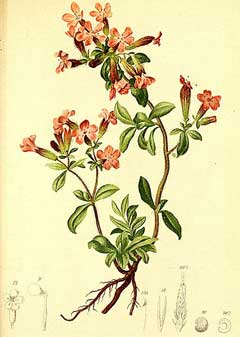 |
|
www.biolib.de |
 |
| http://commons.wikimedia.org/wiki/File:Saponaria_ocymoides_Atlas_Alpenflora.jpg |
Translate this page:
Summary
Bloom Color: Pink. Main Bloom Time: Early summer, Early fall, Late summer, Late spring, Mid summer. Form: Prostrate, Spreading or horizontal.
Physical Characteristics

 Saponaria ocymoides is a PERENNIAL growing to 0.1 m (0ft 4in) by 0.5 m (1ft 8in) at a fast rate.
Saponaria ocymoides is a PERENNIAL growing to 0.1 m (0ft 4in) by 0.5 m (1ft 8in) at a fast rate.
See above for USDA hardiness. It is hardy to UK zone 4 and is not frost tender. It is in flower from July to August. The species is hermaphrodite (has both male and female organs) and is pollinated by Insects.
Suitable for: light (sandy), medium (loamy) and heavy (clay) soils and prefers well-drained soil. Suitable pH: mildly acid and neutral soils. It cannot grow in the shade. It prefers dry or moist soil and can tolerate drought.
UK Hardiness Map
US Hardiness Map
Synonyms
Plant Habitats
Ground Cover; South Wall. In. West Wall. In.
Edible Uses
References More on Edible Uses
Medicinal Uses
Plants For A Future can not take any responsibility for any adverse effects from the use of plants. Always seek advice from a professional before using a plant medicinally.
None known
References More on Medicinal Uses
The Bookshop: Edible Plant Books
Our Latest books on Perennial Plants For Food Forests and Permaculture Gardens in paperback or digital formats.

Edible Tropical Plants
Food Forest Plants for Hotter Conditions: 250+ Plants For Tropical Food Forests & Permaculture Gardens.
More

Edible Temperate Plants
Plants for Your Food Forest: 500 Plants for Temperate Food Forests & Permaculture Gardens.
More

More Books
PFAF have eight books available in paperback and digital formats. Browse the shop for more information.
Shop Now
Other Uses
Soap
All parts of the plant are rich in saponins and can be used as a soap substitute[169]. The saponins are extracted by simmering the plant in water. Plants can be dried for later use[169]. A gentle and effective cleaner[169]. Plants make a good carpeting ground cover when spaced about 60cm apart each way[208].
Special Uses
Ground cover
References More on Other Uses
Cultivation details
Landscape Uses:Border, Container, Ground cover, Rock garden. Requires a gritty well-drained sunny dry position on a wall or the edge of a border creeping over a path[187]. Grows well in sandy and dry soils[188, 190]. Prefers a moisture-retentive soil[200]. Prefers a lime-free soil[1]. Established plants are drought tolerant[190]. Hardy to about -15°c[187]. There are several named forms selected for their ornamental value[200]. Hybridizes with other members of this genus[200]. Special Features:
Not North American native.
References Carbon Farming Information and Carbon Sequestration Information
Temperature Converter
Type a value in the Celsius field to convert the value to Fahrenheit:
Fahrenheit:
The PFAF Bookshop
Plants For A Future have a number of books available in paperback and digital form. Book titles include Edible Plants, Edible Perennials, Edible Trees,Edible Shrubs, Woodland Gardening, and Temperate Food Forest Plants. Our new book is Food Forest Plants For Hotter Conditions (Tropical and Sub-Tropical).
Shop Now
Plant Propagation
Seed - best if given a short cold stratification. Sow autumn or late winter in a cold frame. The seed usually germinates within 4 weeks. When they are large enough to handle, prick the seedlings out into individual pots and grow them on in the greenhouse for their first winter. Plant them out into their permanent positions in late spring or early summer, after the last expected frosts. Division in spring or autumn. Very easy, it can be successfully done at any time in the growing season if the plants are kept moist until they are re-established. Larger divisions can be planted out direct into their permanent positions. We have found it best to pot up the smaller divisions and grow them on in a lightly shaded position in a cold frame, planting them out once they are well established in the summer.
Other Names
If available other names are mentioned here
Native Range
EUROPE: Austria (west), Switzerland, Germany (south), Italy (incl. Sardinia), Slovenia, Spain, France (s. & Corsica)
Weed Potential
Right plant wrong place. We are currently updating this section.
Please note that a plant may be invasive in one area but may not in your area so it's worth checking.
Conservation Status
IUCN Red List of Threatened Plants Status :

Growth: S = slow M = medium F = fast. Soil: L = light (sandy) M = medium H = heavy (clay). pH: A = acid N = neutral B = basic (alkaline). Shade: F = full shade S = semi-shade N = no shade. Moisture: D = dry M = Moist We = wet Wa = water.
Now available:
Food Forest Plants for Mediterranean Conditions
350+ Perennial Plants For Mediterranean and Drier Food Forests and Permaculture Gardens.
[Paperback and eBook]
This is the third in Plants For A Future's series of plant guides for food forests tailored to
specific climate zones. Following volumes on temperate and tropical ecosystems, this book focuses
on species suited to Mediterranean conditions—regions with hot, dry summers and cool, wet winters,
often facing the added challenge of climate change.
Read More
Expert comment
Author
L.
Botanical References
50200
Links / References
For a list of references used on this page please go here
Readers comment
© 2010, Plants For A Future. Plants For A Future is a charitable company limited by guarantee, registered in England and Wales. Charity No. 1057719, Company No. 3204567.